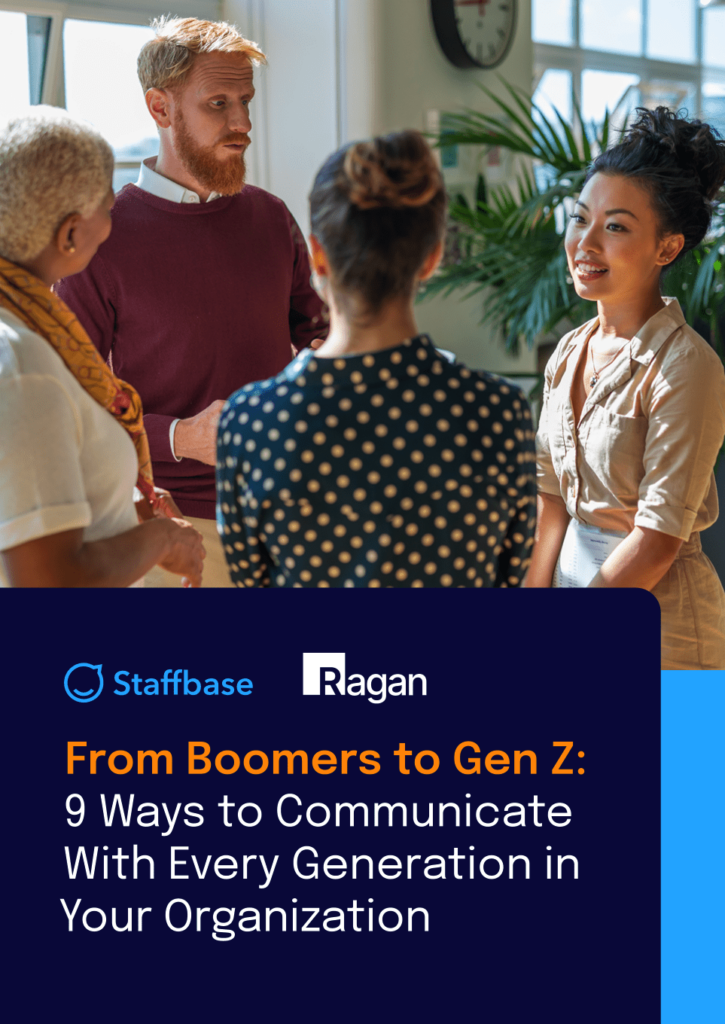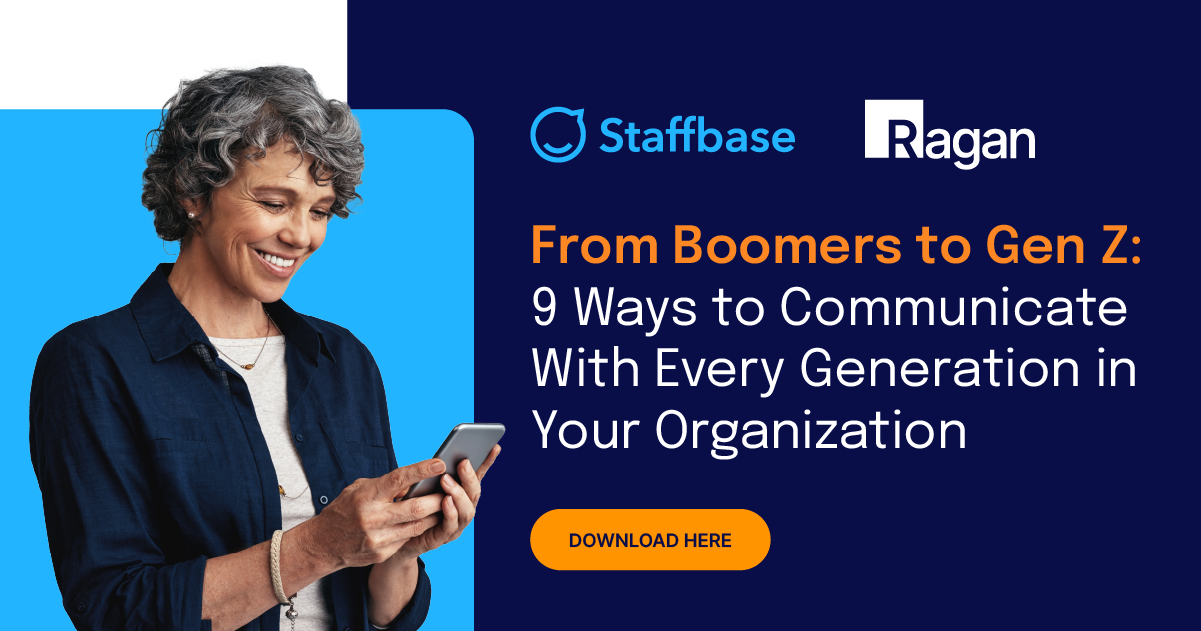From Boomers to Gen Z: 9 Ways to Communicate with Every Generation in Your Organization (+ Free Download)
As workplace demographics broaden, how can you ensure that employees of all generations are receiving your vital messages?

Members of Gen Z are digital natives comfortable with mobile apps and live streaming, but miss important emails in an overcrowded inbox. Baby Boomers tend to prefer print and email, but struggle with adopting new technology. Gen X is the disgruntled middle child who’s tired of being consistently overlooked. When it comes to reaching all generations of employees, your internal comms need to be multigenerational.
It’s time to learn your employees’ favorite channels, broaden your reach, and determine how to drive home your messaging. To help you do so, in conjunction with the comms experts at Ragan, we’ve created a detailed guide outlining what’s required to bridge the gap in nine detailed steps.
In this free download, you’ll learn:
Why it’s necessary to survey your workforce
Who is most likely to appreciate your print publications
How to get “the thumb generation” to participate in Q&As
How to train older workers to adopt apps
Who is most likely to respond to virtual communications
How optimizing for mobile can lure people back to email
How to rethink town halls for a new generation without losing the support of traditionalists
Why a choice of channels means better engagement
How contests can help drive younger workers to your app
Introduction
The Aerospace Corporation in Southern California employs 4,000 people, most of them an older, highly technical staff with doctorates and other advanced degrees.
For years, this government-affiliated nonprofit held a quarterly all-hands meeting that employees could view in person or live via video hookups in remote conference rooms.
Recently, however, the company has been hiring a crop of millennials and Gen Zers. Based on feedback, Aerospace realized it required a new style of internal communications in order to effectively engage these younger staffers. The organization added new options to watch and listen in, including a mobile app enabling both live and retroactive viewing.
“We had to tune up our ability to communicate with all generations almost overnight,” says Sabrina Steele, executive director of corporate communications and public affairs.
Engaging all generations
Most organizations face similar challenges as they strive to engage their newly evolving workforce of mobile-averse Baby Boomers to 20-something digital natives. “It’s important to understand the deeper issues that drive communication preferences,” says Brad Karsh, founder and CEO of JB Training, who has conducted hundreds of workshops on generational differences in businesses.
“Many of the differences in the generations are driven by culture, technology, society, and even parenting,” he says. “How we are raised really ends up being reflected in how we act in the workplace.”
Karsh offers the disclaimer that though much of what he comments on regarding generational characterizations applies to the large majority, there are always exceptions. “But based on our work, there are certain themes that ring true,” he says.
By contrast, millennials and Gen Z grew up in digital environments that exposed them to constant streams of real-time feedback in the form of likes, comments, shares, etc. “Members of Gen Z . . . are true digital natives: from earliest youth they have been exposed to the internet, to social networks, and to mobile systems,” Kinsey & Company reports.
As a result, members of these younger generations have come to expect the same quantity of feedback at work, demanding far more frequent interaction with their supervisors—and their communications.
To simplify, Karsh classifies the workplace into three groups:
Seasoned pros: Those who entered the workforce in an era dominated by print communications.
Mid-careerists: Those whose early jobs overlapped with the rise of email and the internet.
Twenty-somethings: Digital natives at ease with smartphones and impatient with email.
Here are nine tips for reaching audiences of differing ages—and for expanding cross-generational engagement on these channels:

1. Survey your workforce
A few years back, Sabrina Steele admits, she wasn’t thinking about the multigenerational workforce. Today she has to be far more attuned to generational differences and communication preferences.
Start by auditing your comms with a survey while keeping in mind generational preferences in communication, Steele advises. Listen to your workers, and read all the comments in your surveys. “Employees will tell you what they like,” she says.
When you launch a program or channel, ask employees for feedback. If they didn’t like something, ask them to explain why.
2. Only print for seasoned pros
Depending on the audience and industry, seasoned workers tend to favor print publications. EDF Renewables, a company that generates wind and solar power on rented farmland, communicates through print mailings to the farm owners, while relying on a Staffbase mobile app to communicate with its own employees.
The Baby Boomer farmers, says communications manager Christine Karlovic, are “more likely to look at stuff that comes in the mailbox than something that comes in the email inbox. But the farmer’s son, who’s going to be taking over the farm, is more likely to be checking his email.”
3. Enabling texting for younger staffers

When The Aerospace Corp. participates in a space symposium with multiple organizations, Steele often moderates panels. Attendees text in their questions, and she in turn poses the questions to the experts.
People from all generations can ask questions, of course, but the advantage goes to the newer workers, whom Steele refers to as “the thumb generation.”
“If you didn’t grow up texting, you can certainly text, but it’s just not your native communications technique,” she says.
4. Train older workers for widespread app adoption
Half of the 66,000 employees of Otis Elevator Co. work in the field, servicing or building elevators in locations ranging from the Eiffel Tower to the 1,500-foot Petronas Twin Towers in Kuala Lumpur, Malaysia. The mechanics tend to be older, difficult to reach by email, and are generally uncomfortable with apps. Yet a more digitally savvy generation is moving in as their elders retire, says Angela Penn, Otis’s North America Mobility Manager.
Formerly, Otis sent messages via email, but important information was buried in busy inboxes. They now communicate with their field employees through a Staffbase app housed on workers’ smartphones and tablets, says Penn.
“For the younger generation, it was a very easy transformation,” she says. “They have never lived in a time where there was no email. They were very open to moving to mobile apps.” The Baby Boomers needed more support. For security reasons, Otis resets passwords every 90 days, but many older workers then can’t log in. They flood the help desk with calls.
To boost adoption, Otis designed a campaign that sends trainers to all 110 of its branches to provide a half-day “App Reboot” workshop. This initiative has served to substantially increase the adoption rate of the app among all generations.
The return on investment is worth the cost of the trainings, Penn admits. “You can’t ignore the problem. It’s not going anywhere. It’s costing money if users can’t use the tools provided.”
5. If email is a must, optimize it for mobile
Baby Boomers have grown used to email, but 20-somethings are impatient with wordy communications and have a shorter attention span, says Dan Lederer, marketing coordinator for Newport Restaurant Group. With 15 properties in Rhode Island and Massachusetts, the company uses a Staffbase app to stay in touch with a workforce that reaches 1,400 at the height of the summer season.
If email is a must, organizations can improve their chances of engaging younger employees by optimizing it for mobile. Make sure the font is readable on portable devices, add catchy videos and images, avoid wordy prose, and limit subject lines to the 30 characters visible in smartphone applications. Mobile phones allow about 300 characters of preview, so place your call to action and your primary link at the top.
“We only have a brief moment to capture millennials’ attention,” Lederer emphasizes, “and we find that’s even shorter for Gen Z employees, meaning that we just know that they’re scrolling by really fast. We have to put content there that captures their attention.”
6. Virtual communications favor the young
Digitally savvy younger workers tend to be comfortable with video calls, live streams, and webinars. Various platforms enable individuals or teams to make video calls, converse by voice only, or share their screens.
At EDF Renewables, “Most of the people I communicate with on Skype for Business on a daily basis are our younger employees — like 30 and under,” Karlovic says.
In order to increase virtual fluency among older employees, EDF used their Staffbase app to provide technical instruction in the form of short how-to videos. They simultaneously offered instruction on how to use the app’s charitable donation platform, helping boost participation.
7. Rethink town halls for a new generation
Aerospace Corp’s town hall used to be a straightforward affair in which the CEO delivered a script from a lectern. However, the younger hires found this boring, Steele admits — they expected that they wouldn’t just be addressed, but would have the opportunity to engage with speakers.
In response, the company restructured the event, upping the production value with music and video. New CEO Steve Isakowitz, a gifted storyteller, chose to forgo the podium in favor of tall chairs and a talk show format. The younger workers loved it, but the older generations admitted to a sense of discomfort, claiming “This seems superficial. You’ve lost the values,” Steele reports.
Aerospace dialed back the glamour of the production but continued to add new ways to view the meeting (voice call-in, video for desktops and mobile, the intranet after the fact, and an emailed transcription). They found a happy medium with mobile integration, and they’ve had good feedback from employees.
Now the company boasts that nearly 100% of employees view the annual meeting in one form or another.
8. Younger workers love contests
Sports leagues with millions of fans can’t be wrong: all generations love competition. We now know that the competitive spirit also works for comms.
Younger employees in particular respond positively to contests on Newport Restaurant Group’s app. Dan Lederer drums up employee engagement by posing trivia questions about the company’s restaurants, and participants compete to win Yeti mugs or American Express gift cards.
A recent question: Name all the cities in which we have restaurants. “The younger crowd are a lot faster at answering,” Lederer says. “The older generation will eventually get around to it.”
9. Enable choice
Here’s an approach that works across all generations: take a lesson from retailers and let your employees select their preferred means of receiving communications, advises Karsh.
Retailers often ask, “How would you like to get your updates?” Allowing audiences to choose among texts, emails, phone calls, smartphone apps, or other options. Communicators are beginning to do the same thing with both the medium and frequency of their internal messaging.
“We’re moving to a world of increased personalization,” Karsh says, “and personalized communication delivery is logical when it comes to that — both for mode and frequency.”
Conclusion
Generational changes generate new preferences for messaging formats and channels, and communicators must be nimble in responding. Don’t prematurely judge people by their age, but make sure you distribute messages in multiple ways that are compatible with every generation and comms preference.
One of the easiest ways to do so is through a company-wide employee communications cloud and intranet. Combining every channel — from video to chat messaging — in one platform — can be incredibly effective, so long as long as you provide the technical assistance needed to train workers less comfortable on a smartphone.










